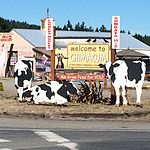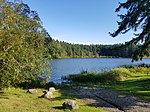Methodist Episcopal Church of Port Hadlock
Buildings and structures in Jefferson County, WashingtonChurches completed in 1903Churches on the National Register of Historic Places in Washington (state)Methodist churches in Washington (state)National Register of Historic Places in Jefferson County, Washington ... and 4 more
Use mdy dates from August 2023Washington (state) Registered Historic Place stubsWashington (state) building and structure stubsWestern United States church stubs

Methodist Episcopal Church of Port Hadlock (Barrett House) is a historic Methodist church, now a private home, at Randolph and Matheson Streets in Hadlock, Washington. Built in 1903, the church was the first permanent Methodist church in Hadlock. The congregation shared a traveling minister with the Methodist church in Chimacum. In the 1950s, the two congregations merged to form a new church; the Hadlock church's old bell and pews were moved to the new church, and the old building became a private residence.The church was added to the National Register of Historic Places in 1983.
Excerpt from the Wikipedia article Methodist Episcopal Church of Port Hadlock (License: CC BY-SA 3.0, Authors, Images).Methodist Episcopal Church of Port Hadlock
Randolph Street,
Geographical coordinates (GPS) Address Nearby Places Show on map
Geographical coordinates (GPS)
| Latitude | Longitude |
|---|---|
| N 48.034147222222 ° | E -122.75653333333 ° |
Address
Randolph Street 130
98339
Washington, United States
Open on Google Maps




